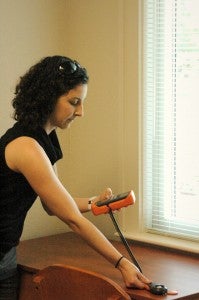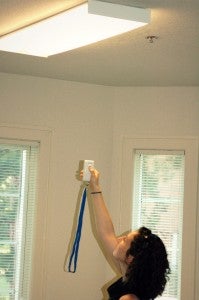By: Carrie Gonnella, 2011 Climate Corps Public Sector Fellow at Catawba College in Salisbury, NC; MEM/MBA candidate at the Nicholas School of the Environment/Fuqua School of Business, Duke University
Two weeks into my EDF Climate Corps Public Sector (CCPS) fellowship, I attended an energy assessment training put on by the State of North Carolina and hosted by the Center for the Environment at Catawba College. This was a great opportunity to expand on what I learned at CCPS training. This three day training included a dozen energy topics, hands-on demos, and a practice energy assessment of a Catawba dormitory.
Dr. Joe Davis, who led the training, works in North Carolina’s Energy Office and has many years of experience in energy assessment. I completed training with 40 representatives from colleges and municipalities. We were eager to develop our understanding of the tools and steps needed in a comprehensive energy assessment. We covered lighting, HVAC, motors, compressed air, boilers, and chillers. Dr. Davis showed us tools that were applicable to each situation. By the end of the training I was able to develop a list of tools that would assist me in my own energy assessment of Catawba’s buildings. Catawba’s Center for the Environment purchased these tools, which will be useful to my work this summer, and can be used as teaching tools in the future. Here are some of the tools:
Infrared Thermometer
Just point the laser at the surface of your choice, press the trigger, and the thermometer instantly reads the surface temperature. This tool allows me to compare the actual room temperature to what the wall thermostat is set at, gauge the temperature of air blowing out of AC vents, and check the temperature around windows to test air exchange between conditioned indoor spaces and the outdoors.

Infrared Thermometer
Electricity Usage Monitor
This meter can record the actual energy usage of any device that plugs into a wall outlet. Just plug the monitor into the wall, plug the device into the monitor, and check back on it after a couple hours, days, or weeks to see the total KWH used. I’ll use this tool to evaluate the efficiency of vending machines, office equipment, and refrigerators.
Light Meter
The light meter measures illuminance in lux or foot-candles. Held at table height, I can gauge how much light is hitting a work surface and compare that data to standard levels for different tasks. If I find an area that has higher illuminance than necessary for the tasks performed there, Catawba could delamp some fixtures to save electricity, money, and emissions.

Light Meter
Ballast Checker
The newer electronic ballasts for fluorescent tubes are more efficient than the traditional magnetic ballast. To quickly tell if a room has magnetic or electronic ballasts, I simply point this device at the ballast and press the button. A green light means I’m looking at an electronic ballast, and a red light means there is efficiency improvement potential if Catawba is able to switch from magnetic to electronic ballasts.

Ballast Checker
I’ve got my bag of tools packed, and I’m ready to explore the energy efficiency opportunities here on Catawba’s campus!
EDF Climate Corps Public Sector (CCPS) trains graduate students to identify energy efficiency savings in colleges, universities, local governments and houses of worship. The program focuses partnerships with minority serving institutions and diverse communities. Apply as a CCPS fellow, read our blog posts and follow us on Twitter to get regular updates about this program.










One Comment
Good tools are critical, but it’s training and experience that matter most, especially when you are auditing commercial, institutional (i.e. colleges), or industrial facilities. I’m glad to see that they gave you some hands on time, and your time at Catawba College.
Are you bringing in outside consultants? If so, ask if you can participate in the audits.